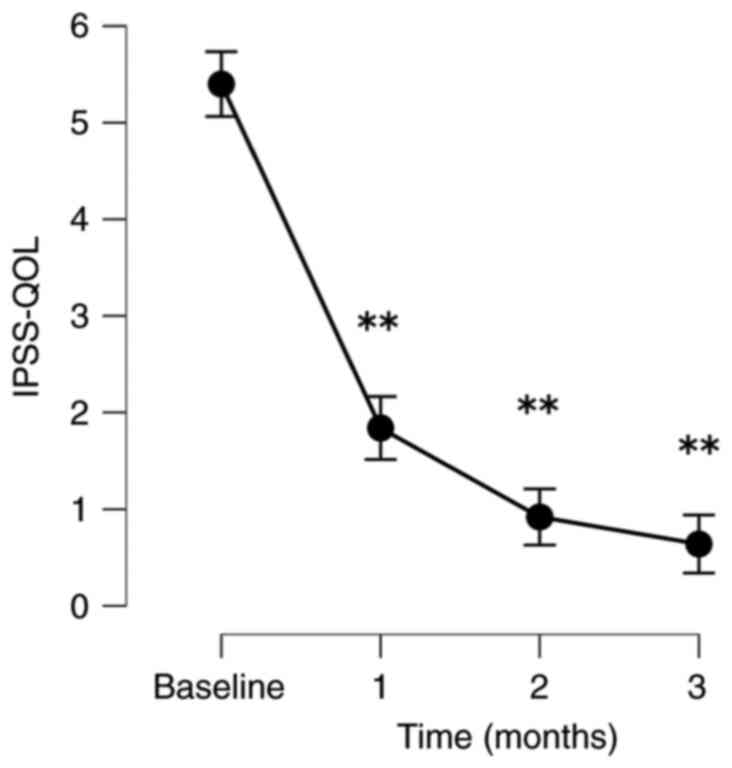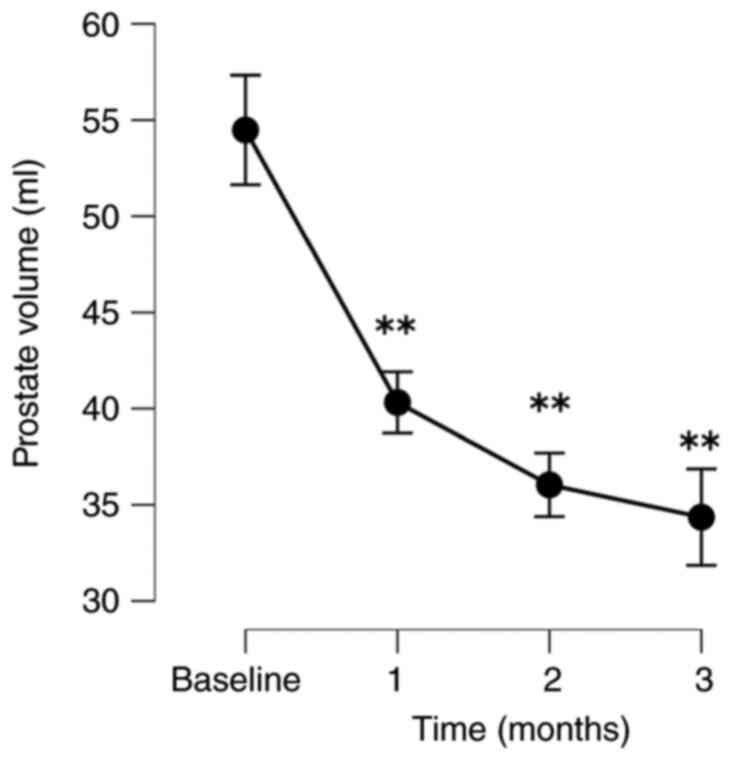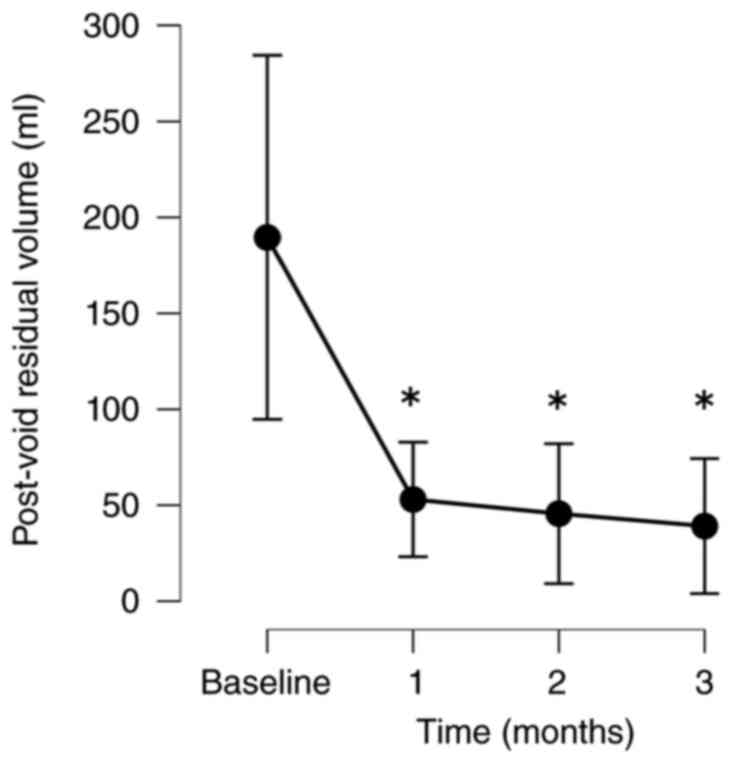A single‑office experience of day‑case water vapor thermal therapy for benign prostatic hyperplasia
- Authors:
- Published online on: June 4, 2024 https://doi.org/10.3892/wasj.2024.249
- Article Number: 34
-
Copyright : © Okabe . This is an open access article distributed under the terms of Creative Commons Attribution License [CC BY 4.0].
Abstract
Introduction
Lower urinary tract symptoms (LUTS) are very common among middle-aged males (1,2). In 40% of males >50 years of age, benign prostatic hyperplasia (BPH) is considered to be the cause of these symptoms (3). BPH is a benign hyperplasia of the periurethral region of the prostate that causes obstructive symptoms that significantly compromise the quality of life of patients. Over the years, numerous therapies have been developed to treat BPH. Although initial medications may be effective for mild to moderate symptoms, patients with moderate to severe symptoms may require surgical intervention. Transurethral resection of the prostate (TURP) has been the most commonly performed procedure and is considered the gold standard for the treatment of BPH (4). Although TURP has demonstrated efficacy in improving urinary symptoms, acute complications and long-term adverse events (AEs), such as erectile and ejaculatory dysfunction, incontinence, and other complications have been reported (5). Some studies have indicated the efficacy and safety of a wide variety of minimally invasive procedures for BPH, such as laser endoscopic enucleation, green light vaporization, prostatic artery embolization and UroLift (6-10). All these procedures aim at avoiding or reducing complications associated with TURP, while maintaining comparable outcomes. Water vapor thermal therapy (WVTT) using the Rezum system, which involves the administration of a transurethral injection of 103˚C water steam into the prostate, is a type of minimally invasive treatment, which has demonstrated beneficial efficacy and safety profiles for the treatment of LUTS caused by BPH (11). A recent randomized clinical trial reported the safety and durable efficacy of WVTT performed in an office-based or ambulatory surgery center (12). The provision of day-case surgery would allow for greater patient flow and improve clinical care through increased efficiency (10).
Therefore, the present study was conducted in an aim to assess the feasibility, safety and efficacy of day-case WVTT as an office-based, outpatient procedure.
Patients and methods
Study design and setting
The present retrospective cohort study was conducted at Mizuhodai Urology in Fujimi, Japan (single-unit urology clinic). The Rezum system (Boston Scientific Corporation) was introduced at the clinic in March, 2023. All Rezum procedures during the study period were performed according to previously published techniques (11,13). Spinal anesthesia was applied for all the procedures.
Patient selection
The present study included the data of 40 patients who underwent the Rezum procedure from March, 2023 to January, 2024, including 11 patients who were catheterized due to complete urinary retention. The inclusion and exclusion criteria used are presented in Table I.
Data collection and definitions
The operation time and hospitalization time on the day of the procedure were analyzed. The patient characteristics, International Prostate Symptom Score-Quality of Life (IPSS-QOL) score, prostate volume (PV), post-void residual (PVR) volume measured by transabdominal ultrasound, catheterization, medication and AEs were monitored at baseline, and at 1, 2 and 3 months following treatment. AEs were defined according to the Clavien-Dindo classification (14).
Statistical analysis
Baseline and follow-up data were reviewed, with follow-up periods of 1, 2 and 3 months. All data are reported with appropriate descriptive statistics as follows: Normally distributed data are reported as the mean ± standard deviation (SD) and non-normally distributed data are reported as the median and interquartile range (IQR). The changes observed in the patients from baseline were analyzed using repeated measures ANOVA followed by the Bonferroni post hoc test for each measure. The influence of a history of urinary retention and more than six injections on prolonged post-operative catheterization (>14 days) was assessed using multivariate logistic regression. A value of P<0.05 was considered to indicate a statistically significant difference. Statistical analysis was performed using JASP (version 0.18.3, team JASP, https://jasp-stats.org/).
Results
Patient characteristics
A total of 40 patients were included in the present study. The median age of the patients was 71.5 years (IQR, 51.0-83.0). The mean PV was 56.9±13.8 ml. Pre-operative catheterization, a history of urinary retention, and a median lobe were present in 27.5, 37.5 and 45.0% of patients, respectively (Table II).
Peri-operative data
All interventions were performed within a median period of 4.0 min (IQR, 2.0-11.0). The patients received a median of five injections (IQR, 4-7) and were hospitalized for a mean duration of 274.8±53.8 min. A total of 5 patients made telephone inquiries during the first post-operative week (Table III).
Catheter management and medication use
The catheter was successfully removed following a median of 12.0 days (IQR, 6.0-87.0) in 39 (97.5%) patients. Catheter removal was successful in 29 (100%) patients without a pre-operative catheter following a median of 8 (IQR, 6.0-16.0) days. In 11 patients with a pre-operative catheter, catheters were successfully removed in 10 (90.9%) patients following a median of 32 (IQR, 28.0-87.0) days (Table III). BPH medications were discontinued by 26 of 40 (65.0%) patients. The median time to discontinuation was 58.0 days (IQR, 24.0-114.0) (Table III). A history of urinary retention and more than six injections during the procedure increased the risk of prolonged postoperative catheterization (>14 days) (Table IV).
Functional outcomes
The patients exhibited significant improvements in their QOL based on their IPSS-QOL scores. The PV and PVR volumes decreased significantly. When comparing baseline to follow-up, the mean post-operative IPSS-QOL scores at 1, 2 and 3 months following treatment decreased significantly by 66.6, 81.7 and 88.0%, respectively. PV significantly decreased by 25.3, 34.0 and 37.2% at 1, 2 and 3 months following treatment, respectively. The PVR volume also decreased significantly from baseline to 1, 2 and 3 months following treatment by 24.0, 23.2 and 40.8%, respectively (Fig. 1, Fig. 2 and Fig. 3). All the related results are presented in Table V.
Safety outcomes
Over the course of the follow-up period, AEs were observed in 11 patients, including Clavien-Dindo grade II gross hematuria in 2 (5%) patients and grade II urinary tract infection (UTI) in 1 (2.5%) patient. In total, 4 patients (10%) had an episode of UTI, and 2 patients (5%) had urinary frequency and dysuria. In addition, 1 patient (2.5%) had an episode of urinary tract pain. No grade ≥III Clavien-Dindo events occurred in any of the patients (Table VI).
Discussion
The aim of the present study was to evaluate the feasibility, efficacy and safety profile of day-case WVTT as an office-based outpatient procedure in a real-world cohort. All interventions were performed within a median period of 4.0 min without intraoperative complications. No case required unscheduled post-operative visits or hospitalization. These results suggest that day-case, office-based WVTT is feasible, similar to other minimally invasive therapies for BPH (10,15,16). In the present study, spinal anesthesia was applied on all procedures, and all patients could leave the office in ~4 h on the day of the procedure. Although a recent meta-analysis revealed that intravenous anesthesia was mainly applied during WVTT (17), the results of the present study suggest that spinal anesthesia may also be considered as an option.
In previous studies, the time to post-operative catheter removal was between 0 and 7 days (11,12,18-20). In the series of patients in the present study, the catheterization time was 8 days in patients without pre-operative catheter-dependent urinary retention (Table III). Furthermore, the present study demonstrated that the catheter-free rate in the subgroup of patients with a pre-operative catheter was 90.9% following a median of 32 days. These results are in accordance with those of a previous study (20). These data also suggest that the time to the first trial of post-operative catheter removal should be prolonged in pre-operatively catheterized patients. Furthermore, the data presented herein indicate that a history of urinary retention significantly increases the risk of prolonged post-operative catheterization. The first trial of post-operative catheter removal should also be prolonged in patients with a history of catheterization. According to the logistic regression analysis performed herein, more than six injections during the procedure significantly increased the risk of prolonged post-operative catheterization. As reported in a previous study, the use of more injections may result in a greater degree of inflammation and tissue edema, which may result in a longer catheterization period (21).
The data of the present study indicate a significant improvement of QOL with a reduction in IPSS-QOL by 66.6% at 1 month following the procedure. This confirms data from prior studies (12,13,22-24). The PV and PVR volume decreased by ~40% at 3 months following treatment. These results are consistent with those of previous studies (12,13,22).
In terms of safety outcomes, AEs were observed in 11 patients, including grade II UTI and gross hematuria; however, no patients had a grade ≥III event. As these results are comparable to those of previous studies (11,12,20), it can be assumed that WVTT can be safely performed as an office-based, outpatient procedure.
The present study has certain limitations, which should be mentioned. The present study was a single-office, retrospective study with a select number of patients. Additionally, a fundamental limitation of the present study was that follow-up time points were not tightly controlled. Despite these limitations, significant improvements in QOL and urinary function were observed at all follow-up time points.
In conclusion, the present study demonstrates that day-case WVTT is feasible, effective and safe as an office-based, outpatient procedure. Further investigations are required however, to determine patient groups for whom WVTT may be indicated and to identify the advantages of WVTT for other minimally invasive treatments for BPH.
Acknowledgements
Not applicable.
Funding
Funding: No funding was received.
Availability of data and materials
The datasets used and/or analyzed in the current study are available from the corresponding author on reasonable request.
Author's contributions
TO conceived and designed the study, obtained the patients' data, performed data analysis, and wrote and edited the manuscript. The author has read and approved the final manuscript. TO confirms the authenticity of all the raw data.
Ethics approval and consent to participate
Written informed consent was obtained from all study subjects for their participation in the present study. Ethical approval was obtained from the Ethics Committee of Mizuhodai Urology (Fujimi, Japan; reference no. 1001). Written informed consent was obtained from the patients for publication of the present study and any related images.
Patient consent for publication
Not applicable.
Competing interests
The author declares that he has no competing interests.
References
|
Vuichoud C and Loughlin KR: Benign prostatic hyperplasia: Epidemiology, economics and evaluation. Can J Urol. 22 (Suppl 1):S1–S6. 2015.PubMed/NCBI | |
|
Wei JT, Calhoun E and Jacobsen SJ: Urologic diseases in America project: Benign prostatic hyperplasia. J Urol. 173:1256–1261. 2005.PubMed/NCBI View Article : Google Scholar | |
|
Zhang SJ, Qian HN, Zhao Y, Sun K, Wang HQ, Liang GQ, Li FH and Li Z: Relationship between age and prostate size. Asian J Androl. 15:116–120. 2013.PubMed/NCBI View Article : Google Scholar | |
|
Foster HE, Dahm P, Kohler TS, Lerner LB, Parsons JK, Wilt TJ and McVary KT: Surgical Management of lower urinary tract symptoms attributed to benign prostatic hyperplasia: AUA guideline amendment 2019. J Urol. 202:592–598. 2019.PubMed/NCBI View Article : Google Scholar | |
|
Friedl A, Schneeweiss J, Stangl K, Mühlstädt S, Zachoval R, Hruby S, Gründler T, Kivaranovic D, Fornara P, Lusuardi L and Brössner C: The adjustable transobturator male system in stress urinary incontinence after transurethral resection of the prostate. Urology. 109:184–189. 2017.PubMed/NCBI View Article : Google Scholar | |
|
Brassetti A, DE Nunzio C, Delongchamps NB, Fiori C, Porpiglia F and Tubaro A: Green light vaporization of the prostate: Is it an adult technique? Minerva Urol Nefrol. 69:109–118. 2017.PubMed/NCBI View Article : Google Scholar | |
|
Checcucci E, Veccia A, De Cillis S, Piramide F, Volpi G, Amparore D, Pecoraro A, Piana A, Granato S, Verri P, et al: New ultra-minimally invasive surgical treatment for benign prostatic hyperplasia: A systematic review and analysis of comparative outcomes. Eur Urol Open Sci. 33:28–41. 2021.PubMed/NCBI View Article : Google Scholar | |
|
Jones P, Rai BP, Nair R and Somani BK: Current status of prostate artery embolization for lower urinary tract symptoms: Review of world literature. Urology. 86:676–681. 2015.PubMed/NCBI View Article : Google Scholar | |
|
Jones P, Rajkumar GN, Rai BP, Aboumarzouk OM, Cleaveland P, Srirangam SJ and Somani BK: Medium-term Outcomes of Urolift (Minimum 12 Months Follow-up): Evidence from a systematic review. Urology. 97:20–24. 2016.PubMed/NCBI View Article : Google Scholar | |
|
Yilmaz M, Karaaslan M, Polat ME, Tonyali S, Aybal HÇ, Şirin ME, Toprak T, Tunç L, Gratzke C and Miernik A: Is day-case surgery feasible for laser endoscopic enucleation of the prostate? A systematic review. World J Urol. 41:2949–2958. 2023.PubMed/NCBI View Article : Google Scholar | |
|
McVary KT, Gange SN, Gittelman MC, Goldberg KA, Patel K, Shore ND, Levin RM, Rousseau M, Beahrs JR, Kaminetsky J, et al: Minimally invasive prostate convective water vapor energy ablation: A multicenter, randomized, controlled study for the treatment of lower urinary tract symptoms secondary to benign prostatic hyperplasia. J Urol. 195:1529–1538. 2016.PubMed/NCBI View Article : Google Scholar | |
|
McVary KT, Gittelman MC, Goldberg KA, Patel K, Shore ND, Levin RM, Pliskin M, Beahrs JR, Prall D, Kaminetsky J, et al: Final 5-year outcomes of the multicenter randomized sham-controlled trial of a water vapor thermal therapy for treatment of moderate to severe lower urinary tract symptoms secondary to benign prostatic hyperplasia. J Urol. 206:715–724. 2021.PubMed/NCBI View Article : Google Scholar | |
|
Dixon CM, Cedano ER, Pacik D, Vit V, Varga G, Wagrell L, Larson TR and Mynderse LA: Two-year results after convective radiofrequency water vapor thermal therapy of symptomatic benign prostatic hyperplasia. Res Rep Urol. 8:207–216. 2016.PubMed/NCBI View Article : Google Scholar | |
|
Dindo D, Demartines N and Clavien PA: Classification of surgical complications: A new proposal with evaluation in a cohort of 6336 patients and results of a survey. Ann Surg. 240:205–213. 2004.PubMed/NCBI View Article : Google Scholar | |
|
Miller LE, Chughtai B, Dornbier RA and McVary KT: Surgical reintervention rate after prostatic urethral lift: Systematic review and meta-analysis involving over 2,000 patients. J Urol. 204:1019–1026. 2020.PubMed/NCBI View Article : Google Scholar | |
|
Sciacqua LV, Vanzulli A, Di Meo R, Pellegrino G, Lavorato R, Vitale G and Carrafiello G: Minimally invasive treatment in benign prostatic hyperplasia (BPH). Technol Cancer Res Treat. 22(15330338231155000)2023.PubMed/NCBI View Article : Google Scholar | |
|
Yang J, Wu W, Amier Y, Li X, Wan W, Liu C, Zhang Y and Yu X: Efficacy and safety of Water Vapor Thermal Therapy in the treatment of benign prostate hyperplasia: A systematic review and single-arm Meta-analysis. BMC Urol. 23(72)2023.PubMed/NCBI View Article : Google Scholar | |
|
Bole R, Gopalakrishna A, Kuang R, Alamiri J, Yang DY, Helo S, Ziegelmann MJ and Köhler TS: Comparative postoperative outcomes of rezūm prostate ablation in patients with large versus small glands. J Endourol. 34:778–781. 2020.PubMed/NCBI View Article : Google Scholar | |
|
Johnston MJ, Noureldin M, Abdelmotagly Y, Paramore L, Gehring T, Nedas TG, Rajkumar G, Emara A and Hindley RG: Rezum water vapour therapy: Promising early outcomes from the first UK series. BJU Int. 126:557–558. 2020.PubMed/NCBI View Article : Google Scholar | |
|
McVary KT, Holland B and Beahrs JR: Water vapor thermal therapy to alleviate catheter-dependent urinary retention secondary to benign prostatic hyperplasia. Prostate Cancer Prostatic Dis. 23:303–308. 2020.PubMed/NCBI View Article : Google Scholar | |
|
Babar M, Loloi J, Azhar U, Tang K, Ines M, Singh S, Iqbal N and Ciatto M: Rezum outcomes in relationship to number of injections: Is less more? J Endourol. 37:157–164. 2023.PubMed/NCBI View Article : Google Scholar | |
|
Bausch K, Zahiti L, Schrutt M, Wetterauer C, Halbeisen FS, Ebbing J and Seifert HH: Water vapor thermal therapy of lower urinary tract symptoms due to benign prostatic obstruction: Efficacy and safety analysis of a real-world cohort of 211 patients. World J Urol. 41:1605–1612. 2023.PubMed/NCBI View Article : Google Scholar | |
|
Elterman D, Bhojani N, Vannabouathong C, Chughtai B and Zorn KC: Rezūm therapy for ≥80-mL benign prostatic enlargement: A large, multicentre cohort study. BJU Int. 130:522–527. 2022.PubMed/NCBI View Article : Google Scholar | |
|
Whiting D, Noureldin M, Abdelmotagly Y, Johnston MJ, Brittain J, Rajkumar G, Emara A and Hindley R: Real-world early outcomes and retreatment rates following water vapour ablative therapy for symptomatic benign prostatic hyperplasia. Eur Urol Open Sci. 39:72–78. 2022.PubMed/NCBI View Article : Google Scholar |











